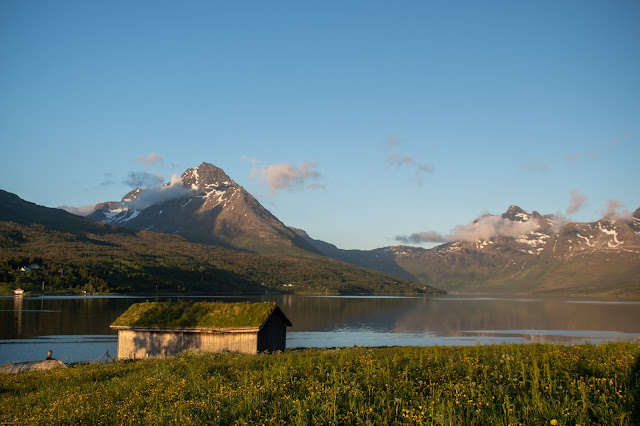July 4th Husøy
÷
The settlement on Husøy is only around 100 years old which in a Norwegian context is really young. As with most local migration on the Norwegian coast the establishment of Husøy is also sort of a result of motorization of the fishing fleet. With heavy engines in the boats it wasn't longer feasible to haul the boats up onto beaches to protect them from storms. In Øyfjordvær and on the other settlements around the fjord the National Harbour Authorities tried to build protected landings for the boats, but time after time these was broken down by storms. The locals in Øyfjordvær demanded a mole, but didn't get one. With a 100 years of hindsight that seems like a wise decision. Looking on all moles in more protected places in Northern Norway it is highly unlikely that they a hundred years ago would have been able to build a mole that would have withstand the storms.
 (In this image the rear of the boat, and the opening of Øyfjorden is fully open to the conditions of the Arctic Sea, Husøya can be glimpsed behind the port outer shrouds)
(In this image the rear of the boat, and the opening of Øyfjorden is fully open to the conditions of the Arctic Sea, Husøya can be glimpsed behind the port outer shrouds) However between the Senja mainland and the small island ,that is now, Husøy conditions for a mole was much better. Since it wasn't possible to beach boats on Husøy and there where no farmable land there it was uninhabited before the 300 m mole was finished in 1926.
 |
| Husøy harbour from the main mole on a extremely unusual calm day |
A relocation support program was established by the authorities in the late 1940:ies and during 1952/53 most of the villagers in the other villages around the outer parts of the fjord relocated with the retainers moving the following few years. Today almost all buildable land on Husøya is settled, there are a couple of prepared but not yet (due to Covid) built upon lots left - but that's it. Any new settlers after that will have to build on mainland Senja across the mole. (And yes population on Husøy is on the up, not much but..)
The school was built in 1949. On a so heavily populated island the schoolyard is somewhat cramped (for a rural school) but I can't imagine any schoolyard elsewhere in the world with more spectacular views.
Until 1975 the only way to get to Husøy (or the other villages in the fjord) was by boat and out in the open Arctic Sea. From 1975 when a tunnel to the bottom of the fjord was finished and a ferry out to Husøy (or actually on the other side of the mole) could be established. And in 1982 the road over (and through the mountains from Stønnesbotn (a new route, not in continuation of the road to the opposite ferry dock)
Husøy became the scene of a reality tv show in 2008 that focused on how the men coped with all women on the island leaving (going on a holiday in Spain).
Even if there where other fish processing industries on Husøy early in its excisions Brødrene Karlsen (=The Karlsen brothers) has always been the cornerstone in the economy in the village. The company is still owned by the same family but management today is the Karlsen sisters (or maybe cousins, I'm not sure).
In many ways Brødrene Karlsen is a traditional fishing village company running not only a fish plant with a wide variety of products but also the village shop. Even selling their own smoked salmon in the shop.



















































